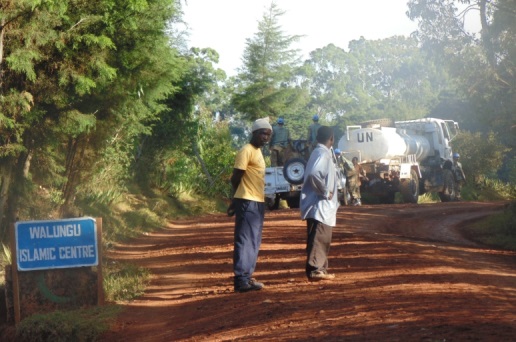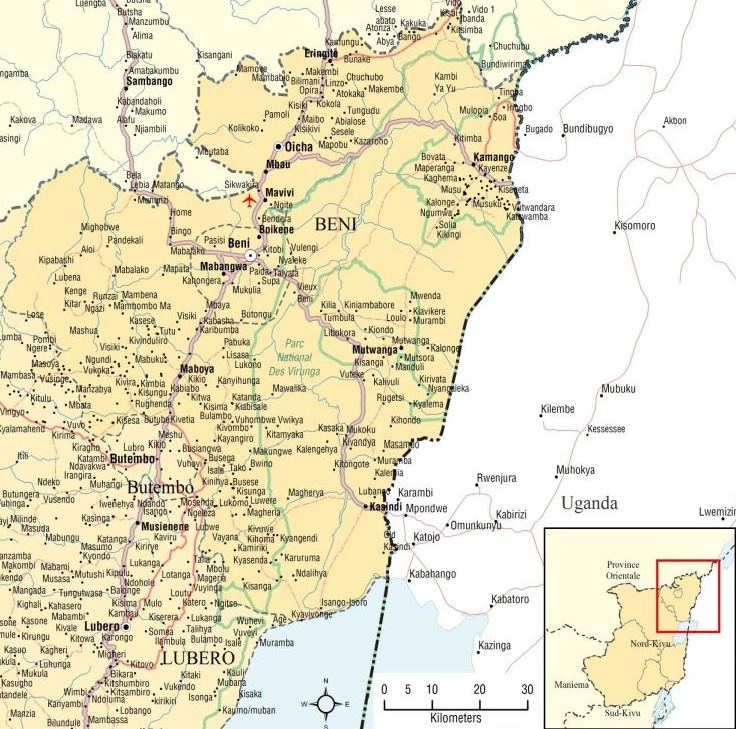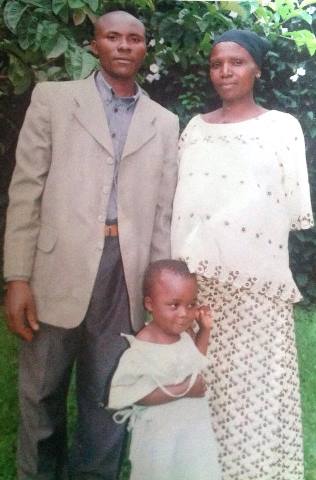
In Africa, it isn’t only in the west that Islamist insurgencies are posing a security threat. While attention has been focused on Nigeria’s radical Islamist group Boko Haram (whose attacks have spread to neighbouring Cameroon, Chad and Niger), a relatively unknown militant group has intensified attacks in the Democratic Republic of Congo (DRC), raising fears of the emergence of a new jihadist organisation in central Africa.
The vast country of DRC borders Uganda, Rwanda, Burundi and Tanzania to its east. A group of militants originally rooted in a rebel movement to overthrow Uganda’s government and replace it with an Islamist fundamentalist state, but forced to re-locate over the border into DRC, has been carrying out murders of local people, far from the attention of most of the world’s major media.
Attacks including murder, looting, abduction and rape are carried out on an almost weekly basis. At least 19 people lost their lives in four separate attacks in September alone, according to local sources. On 26 Sep., two people were killed as their truck was ambushed near Kokola village. Five days earlier, militants fired on a truck between Eringeti and Kokola. The passengers managed to flee unharmed, but the truck was looted and set on fire. On 15 Sep., three people, including two women and a community leader, were killed in Kokola. Three others, including a police officer, were killed near Oicha; they went out to hunt on 5 Sep. but never returned. Their bodies were found three weeks later, beheaded and decaying. Over the same period, 11 people have also been massacred by suspected militants in various other locations in the Beni area.

Beni is a predominantly Christian area, as is most of the DRC, but Independent Catholic News quotes reports that have stated that, within a few years, the number of Muslims in eastern DRC has risen from 1% to 10%.
According to the 2014 Journal of International Organisations Studies, 28 of the 44 mosques (63%) in the Medina region of DRC, about 50 miles from Beni, were erected between 2005 and 2012.
“There were very few Muslims in eastern DR Congo until Islamic missionaries declared sharia over their claimed caliphate between Beni, Eringeti and the border of Uganda,” said a local church leader, who wished to remain anonymous.
“To enforce their caliphate, they killed people along their declared ‘boundaries’ and dumped their bodies to make the point. To those who are carrying out these attacks, we are all Christians and obstacles to Islamic rule with sharia over eastern Congo. But this barely got the world’s attention.”
The National Association for the Liberation of Uganda (NALU) handed itself over to the Ugandan government when their needs were met in 2007.
Local bishops and civil society have, however, repeatedly denounced the resurgence of violence still carried out in the name of ADF-NALU, but which has now taken the form of a jihadist organisation called Muslim Defense International (MDI).
In a letter released in May, the Bishops of the Province of Bukavu (eastern DRC) denounced a “climate of genocide” and the passivity of the Congolese State and international community.
“Does the situation have to deteriorate even more before the international community takes measures against jihadism?” asked the Bishops, according to whom “a strategy of forced displacement of populations is taking place in order to gradually occupy the land and install outbreaks of religious fundamentalism and terrorist training bases”, the Catholic news agency Fides reported.
According to the Beni-based Study Center for the Promotion of Peace, Democracy and Human Rights (CEPADHO by its French acronym), October 2015 marks one year since the beginning of this latest series of deadly attacks, which have claimed about 600 lives in Beni and the surrounding areas, with about 800 kidnapped, according to World Watch Monitor sources. They say the wave of violence has sparked the mass displacement of more than half a million people, including some who have fled to other countries.
A report released in May 2015 by the UN Office for Human Rights in the DRC, covering the period between October 2014 and January 2015, highlights the vulnerability of the Beni population due to the upsurge of violence committed by MDI militants. The attacks it reports were executed in a systematic manner with extreme brutality, as the perpetrators indiscriminately targeted men, women and children, says the report.
“To enforce their caliphate, they killed people along their declared ‘boundaries’ and dumped their bodies to make the point. To those who are carrying out these attacks, we are all Christians and obstacles to Islamic rule.”
Church leader
Most of the victims were killed by machetes, axes and hammers in order to avoid making a lot of noise. Some of them were burned alive in their homes, while others were shot as they were trying to flee. Other victims, including women and children, were mainly abducted in order to carry goods that had been plundered, or enrolled by force to participate in further attacks, or taken as sex slaves.
The recourse to extreme brutality followed a clear strategy aimed at killing “the maximum [number] of individuals within a very short timeframe”, said the UN report, which also revealed that the assailants operate in small mobile groups of between six and several dozen individuals, and use various methods to disguise their attacks. In the majority of cases compiled by the UN, attacks were carried out at sunset, when villagers were returning from working in the fields.
In total, 35 attacks against villages were documented, as combatants engaged in systematic looting, destruction of homes, and theft of domestic animals, food and other goods (such as clothing and kitchen utensils).
Meanwhile, Independent Catholic News reports that about 1,500 children have been taken to remote jihadist camps “where they are being brutalised and indoctrinated by Islamist militia”. Based on reports by the Catholic aid agency, Aid to the Church in Need (ACN), there were signs of at least three training camps, one in Medina.
Maria Lozano, ACN vice-director of communications, said: “We have been given access to a variety of materials that show the nature of these camps. The reports show soldiers wielding rifles, watching over the children – aged nine to 15 – in military outfits, carrying out military exercises. The images we have seen are very disturbing.
“The sudden emergence of the jihadist camps is being linked by ACN sources to UN peacekeeping forces, with concerns that the UN forces are complicit with the camps and that they are intentionally failing to take action against them. It is alleged that some members of the Mission of the UN Organisation for the Stabilization of DR Congo are fundamentalist Muslims from Pakistan who in their spare time are setting up Quranic schools and working on mosque construction sites.”
Churches and clerics targeted
On the night of 16 October, 2014, one attack decimated an entire community, including a pastor and his family.
“Overnight, suspected militants slaughtered 19 people in the neighbouring village of Ngade with machetes, before attacking the nearby Kadohu village,” said the church leader, whose identity is being protected. “Pastor Kanyamanda Jean Kambale and his wife Odette were asleep in their beds with two of their children when they were warned by church members to run. But, as the assailants approached their door laughing and acting in a friendly way, Kambale innocently opened the door to his murderers.

“They dragged him from the house and butchered him with machetes while his wife managed to hide their two little sleeping children in the house. But she was then cut to death with machetes. Before dawn broke over Kadohu, the chief of the village and 13 other residents had been slaughtered with machetes. Most of the victims were members of Kambale’s church, a new community composed of about 40 people, mostly Mbuti Pygmies. Today the Pygmies are possibly in the gravest danger as they are on the outskirts of town and far from protection”.
It’s not the first time churches and clerics were targeted by militants. On 19 October, 2012, three Catholic Assumptionist priests, P. Jean-Pierre Ndulani, Edmond Kisughu and Anselm Wasukundi, were kidnapped from their home in the town of Mbau, in Beni. Local journalists reported that they were taken by an armed militia and later handed over to ADF-NALU. According to local newspaper Les Coulisses, and Radio Kivu 1, they were killed by ADF/MDI a year later because they refused to convert to Islam, but there is no proof of this, and their whereabouts remains unknown.
How was MDI formed?
MDI was founded in the early 1990s following a fusion between the Allied Democratic Forces (ADF), an armed group with a radical Islamist orientation, and the National Army for the Liberation of Uganda (NALU). NALU was a local tribal militia who refused to be governed by the Buganda, the main tribe. They battled for an independent kingdom of Ruwenzori inside Uganda. The two groups shared the common goal of overthrowing the Ugandan government of Yoweri Moseveni, in power since 1986, and (a later goal) replacing it with an Islamic fundamentalist state.
In 1995, after being driven out of Uganda, the group established a base in Beni, a highly volatile region in eastern DR Congo, which has experienced cycles of violence for more than 30 years. Moreover, the Virunga National Park, with its mountainous landscape, offered fertile ground for guerrilla activities. ADF-NALU is believed to have ties with the Somalia-based Al-Shabaab. Its militants come from Uganda, but also Kenya, Somalia, Tanzania, Rwanda, Sudan, Burundi, Central African Republic, and DR Congo.
If the joint military operations carried out by UN troops and the DR Congo Army in April 2014 succeeded in destroying the militants’ main base in the Virunga National Park, the radical Islamist group has conserved its capacity to cause destruction by adopting guerrilla tactics.
MDI constitutes a real security threat for the DR Congo and the entire central African region. It adds to the list of radical groups operating across the continent, with Boko Haram active in Nigeria, Niger, Cameroon and Chad, Al-Qaeda in the Islamic Maghreb (AQIM) and its affiliated groups active across the Sahara region, and the Somalia-based Al-Shabaab in East Africa.